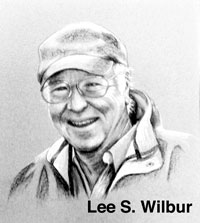Wilbur Yachts Builds a Sailboat

1982. One of the first assertions of exclusive jurisdiction beyond the traditional territorial seas was made by the United States in the Truman Proclamation of 1945. However, it was not until 1982 with the UN Convention on the Law of the Sea that the 200 nautical mile exclusive economic zone (EEZ) was formally adopted internationally. Finally. Now that fish stocks had been severely hammered by multiple foreign countries just beyond the New England 12 mile territorial limit, reaping the benefits of what was left of the fishing grounds. With exclusive rights to the seabed and fishing rights extended out 200 miles and federal low interest loans to build fishing boats in place, building slots soon filled with draggers, gillnetters, and offshore lobsterboats. Pleasure craft slots dropped to minority status. Great feeling of “finally!!” along the coast of New England.
Amidst this frenetic activity, I get a call from Eric White, North End Marine, that he’d just gotten a call from an architect asking if North End would be interested in building a one/off (Moulds for one time use) 41' sailboat for a retired naval captain. North End wanted nothing to do with the “finishing off” so I said, “Sure. Why Not!” I’d always enjoyed a new challenge and the draftsman we’d hired had previously worked for the Hinckley Company and could perhaps could keep a bunch of “stinkpot” builders out of trouble. Plus, as a boatbuilder who had been through a few downturns, my mantra was “if work comes calling...find a way.”

Capt. Dawson’s 1981 flush deck, center board, 41' sloop.
We made a date to meet in Rockland with the Captain, his architect, Eric, and Wes Hauch, North End’s production manager, to work out a schedule along with details of construction. It was in this meeting we learned Capt. Dawson, not a young man, was a singlehanded sailor and the reasoning for the project. “To each his own!”
Few months went by as North End began their part of the building process and we did what little we’d need when parts began arriving. I met once or twice with Capt. Dawson in Rockland, and he’d come to Southwest to go over other details as well. We’d go to lunch, or have him to the house for dinner. The Capt, had an affinity for martinis and lunch could often become a somewhat lengthy affair. However, my father had passed along an interest in military history, and this was an opportunity to talk with someone who had been involved, who’d been in the front lines of defense.
Capt. Dawson’s career had been in aviation as a pilot on aircraft carriers. Instead of purchasing a life insurance policy (of which the premiums must have been extremely high), he and his wife decided to bank that money and invest it throughout his career. Thus he now not only had money for a nice home and a Fillipino house boy who’d followed him from his naval career but after his wife had passed could realize a long held desire to build his own single-handed sailboat.
At some point along the building process, he told me after such a long naval career why he had not been promoted to at least Rear Admiral. After World War II, Chester Nimitze, brilliant, hard driving, naval warrior in the Pacific Theatre had convinced powers that be in the United States Navy the value of Submarines in warfare, Capt. Dawson, refused to sign on, campaigning instead for aircraft delivered missiles working from the carriers. No Admiral slot for the good Captain.
By late summer, parts, hull first, began arriving for “Standfree.” Appropriately named. Eric had warned us “this hull was heavy” and it was. All our overhead cranes wanted when Nick Moody’s truck backed up the rise and on to the shop floor where we lifted her off. As I recall, Standfree, with her hull at some sections two plus inches thick, never moved from her building spot until Nick picked her up again for launching.
Capt. Dawson threw a “Naval” launching party for the crew. Quite wet. We assigned a couple of guys to help him stock Standfree with supplies including ample grog, as we took Standfree out for trial runs. Weather front came through for a good week or so while our Capt. stayed aboard. Once a day I’d send someone down to blow a horn, Capt.’ Dawson’s head would appear out of the companionway, he’d wave, then dissappear again.
Over the next two or three years I’d either get a call or a letter from Capt. Dawson about Standfree and their adventures together. Now this was a man punishing his eighties. Said one call, he’d been roaming the Bahamas, arrived back in Jacksonville, Florida, dead of night, low tide, exhausted, sailed right up through the harbor put her ashore in the mud, threw a hook over the bow, went below, and slept for two days.
In my eighties, I’ll be happy and contented if I can still launch Big Green Canoe from it’s trailer and venture up the Penobscot for a day trip.
Fair Winds and Good Roads
– Lee Wilbur
